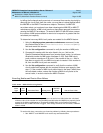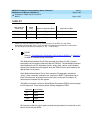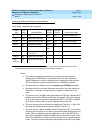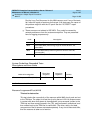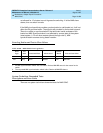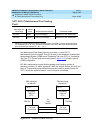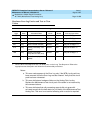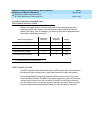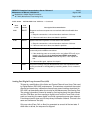
DEFINITY Enterprise Communications Server Release 6
Maintenance for R6vs/si
555-230-127
Issue 1
August 1997
Maintenance Object Repair Procedures
Page 10-863MMI-SYNC
10
MMI-SYNC
NOTE:
Refer to ‘‘Troubleshooting Multimedia Call Handling (MMCH)’’ in Chapter 5
for MMCH troubleshooting information.
Each Port Network (PN) must have a TN787D or later MMI circuit pack assigned
as the Multimedia Interface (MMI) master synchronization source for that PN. If
one or more MMI circuit pack is administered in a PN, one MMI circuit pack is
designated as the master synchronization source for all MMI circuit packs within
that PN.
The MMI circuit pack generates a synchronization signal and puts that signal on
the TDM bus. Other MMI packs or any other circuit pack within a PN can listen to
this signal and “synchronize up” to it. The first MMI circuit pack inserted in a PN
is normally designated as the master. As subsequent MMI packs are inserted,
they are instructed to listen and synchronize to the time-slot of the master MMI. In
the unlikely case of an MMI losing this reference, an uplink message is sent from
the MMI circuit pack that lost the signal to maintenance, which also clears the
“event” counter on this MMI with a downlink message. This forces the MMI circuit
pack to return the current state of the synchronization signal. If the signal is still
lost, then the recovery algorithm is entered. Note that during this time, the MMI
circuit pack synchronizes to its internal clock, and there should be no service
disruption. A loss of synchronization is usually the result of a circuit pack failure.
The maintenance strategy is to switch the master source away from the bad pack
to another healthy MMI circuit pack within the PN.
A synchronization switch takes place if half or more of the MMI circuit packs in a
PN report a loss of synchronization. For example, a PN with two MMIs reporting a
loss of sync source switches immediately, three and four MMIs switch if two
report the loss, and so forth. A healthy MMI circuit pack becomes the master
synchronization source providing the signal on a new timeslot. The other MMI
circuit packs within the PN are instructed to listen to this new signal, and the old
master stops providing the signal and now listens to the new master MMI. If an
MMI is physically removed from the system, then the remaining MMIs report the
loss of synchronization. The first MMI with no alarms present becomes the new
master of that PN. Once a synchronization switch has occurred, another switch is
1. Where P is the port network number (1 for PPN and 2 or 3 for EPN); C is the carrier designation (for
example, A, B, C, or D); and SS is the address of the slot in the carrier where the circuit pack is
located (for example, 01, 02, ..., and so forth).
MO Name (in
Alarm Log)
Alarm
Level Initial Command to Run
1
Full Name of MO
MMI-SYNC MINOR test board PCSS l r# Multimedia Interface Circuit Pack



